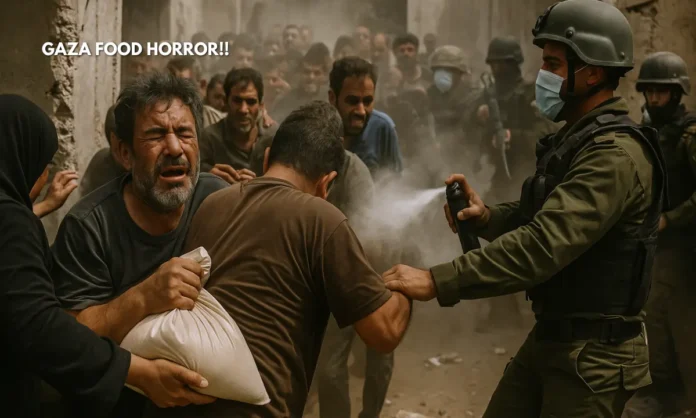SUMMARY
- At least 20 Palestinians died in a crowd surge at a U.S.-backed food aid site run by GHF in Khan Younis.
- Eyewitnesses and Gaza health officials blame pepper spray, teargas, and Israeli crowd restrictions for the stampede.
- GHF, backed by the Trump administration, denies responsibility and blames Hamas for instigating chaos.
Humanitarian Collapse or Weaponized Relief?
A routine morning trip for food in southern Gaza turned fatal on July 16, when at least 20 Palestinians were crushed or suffocated at a distribution site managed by the U.S.-funded Gaza Humanitarian Foundation (GHF). The site near Khan Younis, one of only four operated by the group in the besieged strip, descended into chaos as security guards reportedly deployed pepper spray—and possibly teargas—on crowds desperate for food.
This marks the first mass-casualty incident directly linked to GHF’s controversial model of armed humanitarianism, implemented as a replacement to UN and NGO-led relief systems. As suffocation symptoms were confirmed by Gaza’s hospitals, GHF pointed fingers at Hamas, calling the surge “a provocation.” The fallout underscores not just a logistical failure, but a systemic crisis where politics, famine, and militarised aid collide—with deadly consequences.
Two US contractors working for the 'Gaza Humanitarian Foundation', speaking to AP on condition of anonymity, have come forward to say their colleagues regularly used stun grenades, pepper spray, and live ammunition on hungry Palestinians trying to reach food aid, even if there… pic.twitter.com/zTITPxP0R7
— TRT World (@trtworld) July 3, 2025
What Happened Outside Khan Younis: Witnesses vs GHF
- GHF says 19 people were trampled, one stabbed during a “Hamas-instigated” surge.
- Gaza Health Ministry says 15 died of suffocation from teargas, citing telltale physical signs.
- A grieving uncle describes Israeli barricades, gas canisters, and the desperate rush to escape.
Palestinian officials and bereaved families painted a harrowing picture: Israeli forces narrowed access corridors and GHF guards fired gas canisters at a packed crowd. “They stepped on his head and stomach,” said the uncle of 20-year-old victim Mohammad Rouqa. “He lost his life trying to get a can of beans.”
GHF disputes the entire narrative, claiming no teargas was used and insisting pepper spray was deployed only “to protect life.” It also accused Hamas of planting armed agitators and attempting to destabilise their operations—allegations for which no evidence has been made public.
GHF’s Rise: Mercenaries, Shadow Aid, and U.S. Controversy
- GHF is a start-up humanitarian group with no prior conflict zone experience.
- The Trump administration just pledged $30 million in U.S. taxpayer funds to GHF.
- Senator Chris Van Hollen called it “a shadowy group replacing NGOs with mercenaries.”
The Gaza Humanitarian Foundation emerged this May after Israel suspended coordination with the UN and accused existing agencies of allowing aid diversion to Hamas. Unlike UN agencies, GHF runs only four food distribution points for 2 million people, opens them irregularly, and staffs them with private armed guards.
In contrast, the previous aid model relied on 400 sites and embedded community networks. “This was always a recipe for death,” said a former WFP logistics officer, adding that “you can’t replace structure with spectacle.”
Democratic leaders in the U.S. are furious. Senator Van Hollen directly blamed GHF for Wednesday’s deaths, calling the incident “an outrage” and accusing the Trump administration of dismantling credible humanitarian pathways.
Mounting Death Toll and Famine Risks
- Over 58,000 Palestinians have died in the war—most civilians.
- Since May, at least 800 people have been killed trying to access food, mostly near GHF sites.
- UN food security experts warn of “systemic starvation” if the current model persists.
This week’s incident wasn’t an isolated tragedy. According to local data, hundreds have been killed at or near GHF-run sites, often from gunfire or stampedes. Experts fear more such surges are inevitable.
The stampede also coincided with another Israeli airstrike that killed 13 members of a single family, including seven children. Rescuers were reportedly prevented from accessing the rubble for eight hours due to Israeli drone activity—underscoring the broader humanitarian gridlock in Gaza.
Meanwhile, GHF continues to operate under limited scrutiny, bolstered by fresh U.S. funds but mounting civilian casualties. “They’re distributing death alongside aid,” said one anonymous local official.
The Humanitarian Experiment That Failed Gaza
The July 16 tragedy is more than a failed crowd control incident—it is the culmination of a radical humanitarian shift. By replacing transparent, coordinated relief with a militarised, opaque network, GHF turned hunger into a high-risk gamble. For thousands of Gazans, food queues now resemble frontlines.
The political gamble behind GHF’s deployment—anchored in distrust of multilateralism and an ideological rejection of the UN—has thus far yielded stampedes, suffocation, and shockwaves through global aid circles. With only four sites to feed 2 million people, and no clear plan for local integration or crisis response, GHF’s future—and Gaza’s food security—hang in the balance.
As public outcry builds and even conservative donors raise alarms, the question remains: how many more lives must be lost before humanitarian principles trump political experiments?


